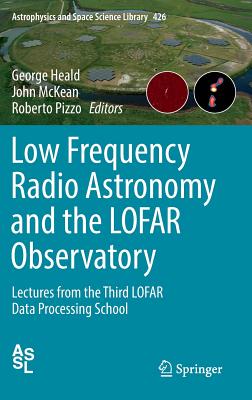You are here
Back to topLow Frequency Radio Astronomy and the Lofar Observatory: Lectures from the Third Lofar Data Processing School (Astrophysics and Space Science Library #426) (Hardcover)
Email or call for price
Description
Introduction to Low Frequency Radio Astronomy.- LOFAR Overview.- LOFAR station processing.- RFI flagging, Demixing and Visibilities Compression.- Correlator and Online Processing.- Introduction to Calibration.- Error Analysis in LOFAR Data.- Calibration of LOFAR interferometric data.- Ionospheric Effects.- Wide Field Imaging.- The Standard Imaging Pipeline.- Polarization Imaging with LOFAR.- Long Baseline Imaging with LOFAR.- Calibration of LOFAR Spectral Line data.- Beam-formed Data with LOFAR.- Particle Physics with LOFAR.- High Time Resolution with LOFAR.
About the Author
About the Editors: George Heald received his PhD in 2006 from the University of New Mexico, Albuquerque, USA. He has held several leadership roles within the LOFAR collaboration as well as other international radio astronomy projects such as the Murchison Widefield Array (MWA). He now holds the position of Science Leader at the Commonwealth Scientific and Industrial Research Organisation (CSIRO), Australia's science agency, where he leads a research team focused on the low-frequency component of the forthcoming Square Kilometre Array (SKA). Roberto Pizzo received his PhD in Astronomy in 2010 from the University of Groningen, The Netherlands. In his career, he has lead various LOFAR projects as well as several programs associated with other radio facilities, such as WSRT/APERTIF. Currently, he is the Head of Science Operations and Support for LOFAR and WSRT/APERTIF at the Radio Observatory of ASTRON. In this position, he leads a team of astronomerstackling the challenges which will be common to next generation radio facilities, such as the Square Kilometre Array (SKA).John McKean received his PhD in Radio Astronomy from the University of Manchester, United Kingdom, in 2004. He has held various research positions at the University of California, the Max Planck Institute for Radio Astronomy and the Netherlands Institute for Radio Astronomy, with scientific interests in galaxy formation and testing models with dark matter using very long baseline interferometry. He is currently Professor for Radio Astronomy at the University of Groningen and a Staff Astronomer at the Netherlands Institute for Radio Astronomy. His work at low frequencies is focussed on studying particle energetics within radio galaxies and high resolution imaging of gravitational lenses with the International LOFAR Telescope.

